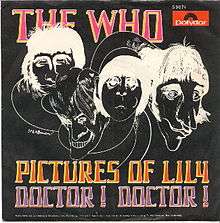Pictures of Lily
| "Pictures of Lily" | |||||||
|---|---|---|---|---|---|---|---|
 | |||||||
| Single by The Who | |||||||
| B-side | "Doctor, Doctor" | ||||||
| Released |
22 April 1967 (UK) 24 June 1967 (US) | ||||||
| Format | Vinyl record (7") | ||||||
| Recorded | 5 April 1967 at IBC Studios, London, UK | ||||||
| Genre | Power pop[1] | ||||||
| Length | 2:44 | ||||||
| Label | Track | ||||||
| Writer(s) | Pete Townshend | ||||||
| Producer(s) | Kit Lambert | ||||||
| The Who singles chronology | |||||||
| |||||||
| |||||||
"Pictures of Lily" is a single by the British rock band The Who, written by guitarist and primary songwriter Pete Townshend. It was released in 1967 as a single, and made the top five in the UK, but failed to break into the top 50 in the United States. In 1971, "Pictures of Lily" was included in the Who album Meaty Beaty Big and Bouncy, a compilation of previously released singles.
Townshend coined the term "power pop" when he used it to describe the song in a May 1967 interview with NME.[2]
Synopsis
In the beginning of the song, the singer laments his inability to sleep. When his father gives him the pictures of the song's eponymous Lily, he feels better, and is able to sleep. Soon, he feels desire for Lily as a person instead of a photo, and asks his father for an introduction. His father informs him however that "Lily" has, in fact, been dead since 1929. Initially, the singer laments, but before long turns back to his fantasy.
Meaning and origin
According to Pete Townshend in the 2006 book Lyrics by Rikky Rooksby, "the idea was inspired by a picture my girlfriend had on her wall of an old Vaudeville star – Lily Bayliss [sic]. It was an old 1920s postcard and someone had written on it 'Here's another picture of Lily – hope you haven't got this one.' It made me think that everyone has a pin-up period."
Lillie Langtry, the music hall star, died in 1929, the year mentioned in the song. Townshend's statement is unlikely to refer to Lilian Baylis, the theatre manager, who died in 1937.[3]
Mark Wilkerson quotes Townshend as writing that the song is "Merely a ditty about masturbation and the importance of it to a young man."[4] However, the song does not mention masturbation explicitly.
Live performances
This song was first played live in 1966, and they continued to play through whilst touring until 1968. It returned to make a one-off appearance at a show in Passaic, New Jersey on 11 September 1979, where singer Daltrey forgot the lyrics and they went straight to Free's "All Right Now", which the band performed on rare occasions in the 1970s. Daltrey performed this four times in his 1985 solo tour. The Who returned it to their set list in 1989, and Daltrey performed it during his 2009 Use It Or Lose It solo tour. The song was also performed during the Who's 2015 The Who Hits 50! tour.
Recording in the studio
During the period that the song was recorded, in 1967, Kit Lambert, the band's first "real" manager, according to Townshend, mixed the song. He filmed the band recording the song, showing the four bandmates performing, with Keith Moon being recruited for the high notes in the song (even though Pete Townshend can be heard telling Keith he "keeps jumping on John's part", however, other live video footage shows John Entwistle, the band's bassist harmonizing and playing the French Horn. Daltrey has said the French horn solo was an attempt to emulate a World War I klaxon warning siren, as the Lily girl was a World War I-era pinup.
Cover versions
- The song has been covered by David Bowie on Substitute: The Songs Of The Who, a 2001 tribute album.[5]
- It was covered by Argentinian punk band Attaque 77 in Spanish on their cover album Otras Canciones.
References
- ↑ Unterberger, Richie. "Pictures of Lily – Song Review". AllMusic. All Media Network. Retrieved 7 August 2016.
- ↑ Altham, Keith. "Lily Isn't Pornographic, Say Who". NME (20 May 1967).
- ↑ John Atkins Mark Wilkerson The Who on record: a critical history, 1963–1998, p. 87
- ↑ Mark Wilkerson, (2006), "Amazing Journey: The Life of Pete Townshend", ISBN 1-4116-7700-5, ISBN 978-1-4116-7700-5
- ↑ Cover Story: David Bowie covers The Who – "Pictures Of Lily" | Popservations
